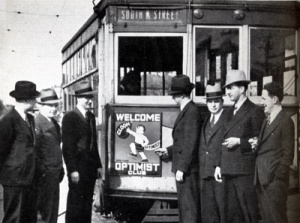“I propose a new classification of membership in Optimism … Life Membership,” Schaffert said. “The Life Membership is unusual in that Optimist International will get some ready cash with which to work and will not have to pay it back. “Several members have offered to lend money to International to put over an extension program, but this would mean Optimism would assume an obligation which must be repaid. “A Life Membership is not something we expect every member to take. We are only going to ask those members to take it who want it. “The plan is to sell a Life Membership for $100 cash—or a down payment of one-third and two payments each six months thereafter. “The officers who will have the duty and privilege of administrating these monies so received are men of sufficient caliber, honesty and sincerity that they will guard that money even more so than if it were their own. “I want to tell you that I stayed up nights until two or three o’clock in the morning, trying to figure out a way to build clubs without money. It is just impossible to get enough of the type of men whom we need to go out and build clubs, without some assurance they are going to be able to eat and sleep while they are on the road. We need money to give these men something to live on!” The proposal, and its acceptance by the delegates, marked a milestone in the short history of Optimist International. It was a simple, easily understood plan: Those Optimists who wished to do so could, for $100, pay their International dues for the rest of their lives. The dues they paid thenceforth to their local Clubs would be reduced to the extent of the International dues. Money paid for Life Memberships would be used exclusively for the building of new Clubs. No sooner had Schaffert finished speaking than A.S. Hull of Austin, Texas, leapt to his feet and declared, “I will buy Life Membership number one.” A split second behind him was John F. Tyrell of Milwaukee. “I want Life Membership number one and I’ll raise you $50 for it!” Hull responded, “I will step aside in favor of a great Optimist because I have been in Optimism only one year.” President Walter Pray thanked the comparative newcomer and accepted the switch. Life Membership number one went to Tyrell, number two to Hull. |
Pray started to say he’d take number three but Thomas O’Keefe of Detroit (who became International President three years later) beat him to the punch. Walter Hoffman of Vernon, Texas, spoke up for number four and the President, exercising his prerogative, rapped for order and suspended the bidding until he could get his own name in the pot as Life Member number five. A steady stream of Optimists was recognized by the presiding officer until 100 Life Memberships had been taken and $10,000 had been pledged to Optimist International for new Club building. Results of the new expansion program were not long in arriving. During the following month, July 1936, The Optimist magazine reported that a new record had been set for chartering new Clubs in one month … four, in Columbia, Missouri; Norfolk, Virginia; Jacksonville, Florida; and Hutchinson, Kansas. |
 During the week that the Tacoma, Washington, Optimist Club was chartered, "Welcome Optimist" signs popped up on street cars and in the front windows of businesses throughout the city. The Tacoma mayor also declared March 7, the day of the charter, as "Optimist Day." |
Total membership had risen from 5,540 three years earlier to 7,020 in July 1936. And there were now 105 Junior Optimist Clubs with 3,099 members. By now, Optimism had passed the low point in its battle against the Great Depression. Membership had dipped to a low of 4,575 in October 1933, but the grim days were apparently behind them. In 1936-37, the organization boasted the greatest net membership increase of any year in its history. As the decade of the 1930s ended, membership in Optimist International had climbed to 11,129, or more than twice what it had been just six years earlier, in 1934. Optimism was again high among those who had weathered the storm, but new clouds were forming on the horizon that would present even greater challenges as the calendar turned over to 1940. |